The total production number for the Toyota T100 from 1993 to 1998 was approximately 141,531 units in the U.S., a figure we at millertoyota.net can confirm, underscoring its unique, albeit less commercially successful, place in Toyota’s history. Its blend of Toyota’s renowned reliability with a size that bridged the gap between compact and full-size trucks set it apart. Discover more about Toyota’s innovative designs and dependable service options at Miller Toyota, your premier Toyota dealer in Boise, Idaho.
1. What Were the Total Toyota T100 Production Numbers?
Approximately 141,531 Toyota T100s were produced for the U.S. market between 1993 and 1998. While Toyota T100 sales peaked in 1995 and 1996, this figure pales compared to the sales numbers of domestic full-size pickup trucks during the same period, as noted by automotive industry analysts. This production number reflects the T100’s niche positioning and unique design elements, which catered to a specific segment of pickup truck buyers. For those in Boise, Idaho, exploring a diverse range of Toyota trucks, millertoyota.net offers a comprehensive selection, including both new and pre-owned options.
2. Why Was the Toyota T100 Introduced?
The Toyota T100 was introduced to penetrate the burgeoning full-size pickup truck market in the United States in the early 1990s. Toyota aimed to offer a reliable, refined alternative to the domestic trucks, leveraging its reputation for quality and durability. The T100 was designed to appeal to buyers who wanted a truck that was more manageable in size and easier to drive than traditional full-size pickups. While it didn’t capture a large market share, the T100 paved the way for the later, more successful Toyota Tundra. At millertoyota.net, we appreciate Toyota’s pioneering spirit and are committed to helping you find the perfect truck to fit your needs.
3. What Made the Toyota T100 Unique Compared to Other Trucks?
The Toyota T100 stood out due to its manageable size, Toyota’s renowned reliability, and a more refined interior than its American counterparts. Unlike the larger, more powerful full-size trucks from Ford, Chevrolet, and Dodge, the T100 offered a blend of comfort and practicality that appealed to a different type of truck buyer. Its smooth ride and car-like handling made it a unique offering in the pickup truck segment. At millertoyota.net, we understand that every driver has unique needs, and we’re here to help you explore the features that set Toyota vehicles apart.
4. What Were the Engine Options Available for the Toyota T100?
The Toyota T100 initially came with a 3.0-liter V6 engine, producing 150 horsepower and 180 lb-ft of torque. Later models featured a 2.7-liter inline-4 and an upgraded 3.4-liter V6, which offered 190 horsepower and 220 lb-ft of torque. While these engines provided adequate power for many tasks, they were less powerful than the V8 engines offered by domestic full-size trucks. This difference in power contributed to the T100’s perception as a smaller, less capable truck in the eyes of some buyers. If you’re looking for a truck with impressive power and efficiency, visit millertoyota.net to explore the latest Toyota truck models and engine options.
5. What Were the Key Features and Specifications of the Toyota T100?
Key features of the Toyota T100 included a standard 8-foot bed with the regular cab, or a 6.3-foot bed with the extended “Xtracab,” which was introduced in 1995. The T100 was smaller than its full-size competitors, making it easier to maneuver and park. Its interior was praised for its high-quality materials and build quality, setting it apart from other trucks of the era. Despite its strengths, the T100 lacked certain features that were popular among full-size truck buyers, such as a V8 engine and a true four-door cab. At millertoyota.net, we provide detailed specifications for all Toyota models, helping you make an informed decision.
6. How Did the Toyota T100 Perform in Terms of Sales and Market Reception?
The Toyota T100 did not achieve the sales success Toyota had hoped for, never surpassing 40,000 units sold in a single year. Its market reception was mixed, with some buyers appreciating its reliability and manageable size, while others desired the greater power and capabilities of traditional full-size trucks. The T100’s limited success led Toyota to develop the larger, more powerful Tundra, which has since become a strong competitor in the full-size truck market. At millertoyota.net, we’re proud of Toyota’s evolution in the truck segment, and we’re here to help you find the perfect Toyota truck for your needs.
7. What Factors Contributed to the Toyota T100’s Limited Success?
Several factors contributed to the Toyota T100’s limited success, including its smaller size, lack of a V8 engine, and limited cab configurations. The T100 was seen as a “tweener” truck, falling between the compact and full-size segments. Its underpowered engines and smaller dimensions made it less appealing to buyers who needed a truck for heavy-duty work or towing. Additionally, the T100 faced strong competition from established domestic brands with loyal customer bases. At millertoyota.net, we understand the importance of meeting customer expectations, and we’re committed to providing you with the information you need to make the right choice.
8. How Did the Toyota T100 Pave the Way for the Toyota Tundra?
The Toyota T100 served as a valuable learning experience for Toyota, providing insights into the needs and preferences of American truck buyers. The T100’s shortcomings highlighted the importance of size, power, and cab configurations in the full-size truck market. Toyota used this knowledge to develop the Tundra, a larger, more powerful truck with a V8 engine and a range of cab options. The Tundra has since become a successful competitor in the full-size truck segment, demonstrating Toyota’s ability to adapt and innovate. At millertoyota.net, we’re proud to offer the Tundra, a testament to Toyota’s commitment to excellence.
9. What Are Some Common Problems and Reliability Issues with the Toyota T100?
Like any vehicle, the Toyota T100 had its share of common problems and reliability issues. Some owners reported issues with the automatic transmission, particularly in early models. Others experienced problems with the engine, such as oil leaks and premature wear. However, overall, the T100 was known for its reliability and durability, a hallmark of Toyota vehicles. Regular maintenance and timely repairs can help prevent many of these issues and keep your T100 running smoothly. At millertoyota.net, our certified technicians are experts in Toyota maintenance and repair.
10. Where Can I Find a Toyota T100 for Sale or Service in the Boise Area?
Finding a Toyota T100 for sale may require some searching, as they are no longer in production and are becoming increasingly rare. However, you may be able to find a used T100 through online marketplaces, auctions, or private sellers. For service and maintenance on your Toyota T100 or any other Toyota vehicle, visit millertoyota.net in Boise, Idaho. Our experienced technicians provide top-quality service using genuine Toyota parts, ensuring your vehicle stays in top condition.
11. How Did Toyota Market the T100?
Toyota marketed the T100 as a versatile and reliable alternative to traditional full-size trucks, targeting buyers who valued quality, comfort, and ease of driving. Advertisements emphasized the T100’s smooth ride, refined interior, and Toyota’s reputation for dependability. Toyota also highlighted the T100’s smaller size and maneuverability, positioning it as a practical choice for urban environments and everyday use. While the marketing message resonated with some buyers, it wasn’t enough to overcome the T100’s limitations in terms of power and capability. At millertoyota.net, we understand the importance of clear and effective marketing, and we strive to provide you with the information you need to make an informed decision.
12. What Design Elements Made the T100 Unique?
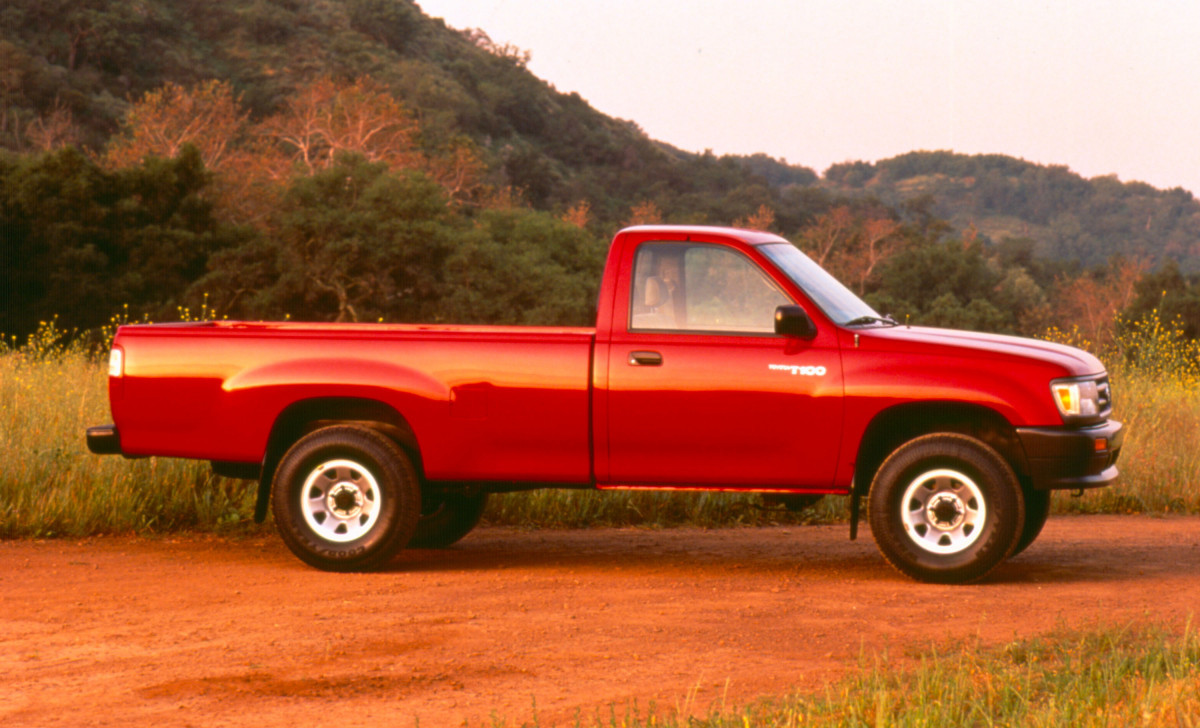 Toyota T100 red
Toyota T100 red
The Toyota T100 featured a distinctive design that set it apart from other trucks on the road. Its rounded body lines, integrated bumpers, and smooth grille gave it a more modern and aerodynamic appearance. The T100’s cab was also designed with comfort and convenience in mind, featuring a spacious interior, ergonomic controls, and ample storage space. While the T100’s design was generally well-received, some critics felt that it lacked the rugged and aggressive styling of its American counterparts. At millertoyota.net, we appreciate Toyota’s attention to detail and commitment to design excellence, and we’re here to help you find a Toyota vehicle that fits your personal style. The Toyota T100 in a striking red color, showcasing its sleek design.
13. What Was the Towing Capacity of the Toyota T100?
The towing capacity of the Toyota T100 varied depending on the engine and configuration. Models with the 3.0-liter V6 engine could tow up to 5,200 pounds, while those with the 3.4-liter V6 engine could tow up to 5,400 pounds. While these figures were respectable for a truck of its size, they were lower than the towing capacities of many full-size trucks. If you need a truck with serious towing power, visit millertoyota.net to explore the latest Toyota Tundra models, which offer impressive towing capabilities.
14. How Did the Toyota T100 Compare to the Nissan Pickup of the Same Era?
The Toyota T100 and the Nissan Pickup were both Japanese-made trucks that competed in the North American market in the 1990s. However, they were aimed at different segments. The Nissan Pickup was a compact truck, while the T100 was positioned as a mid-size or light-duty full-size truck. The T100 was larger and more powerful than the Nissan Pickup, but it was also more expensive. Both trucks were known for their reliability and durability, but the T100 offered a more refined driving experience.
15. What Type of Buyer Did the Toyota T100 Appeal To?
The Toyota T100 appealed to buyers who wanted a reliable, comfortable, and easy-to-drive truck that was smaller and more manageable than traditional full-size pickups. These buyers often used their trucks for commuting, light hauling, and recreational activities. They valued Toyota’s reputation for quality and dependability and appreciated the T100’s smooth ride and refined interior. While the T100 didn’t capture a large share of the full-size truck market, it found a niche among buyers who prioritized practicality and reliability over power and capability.
16. What Were the Interior Design Features of the Toyota T100?
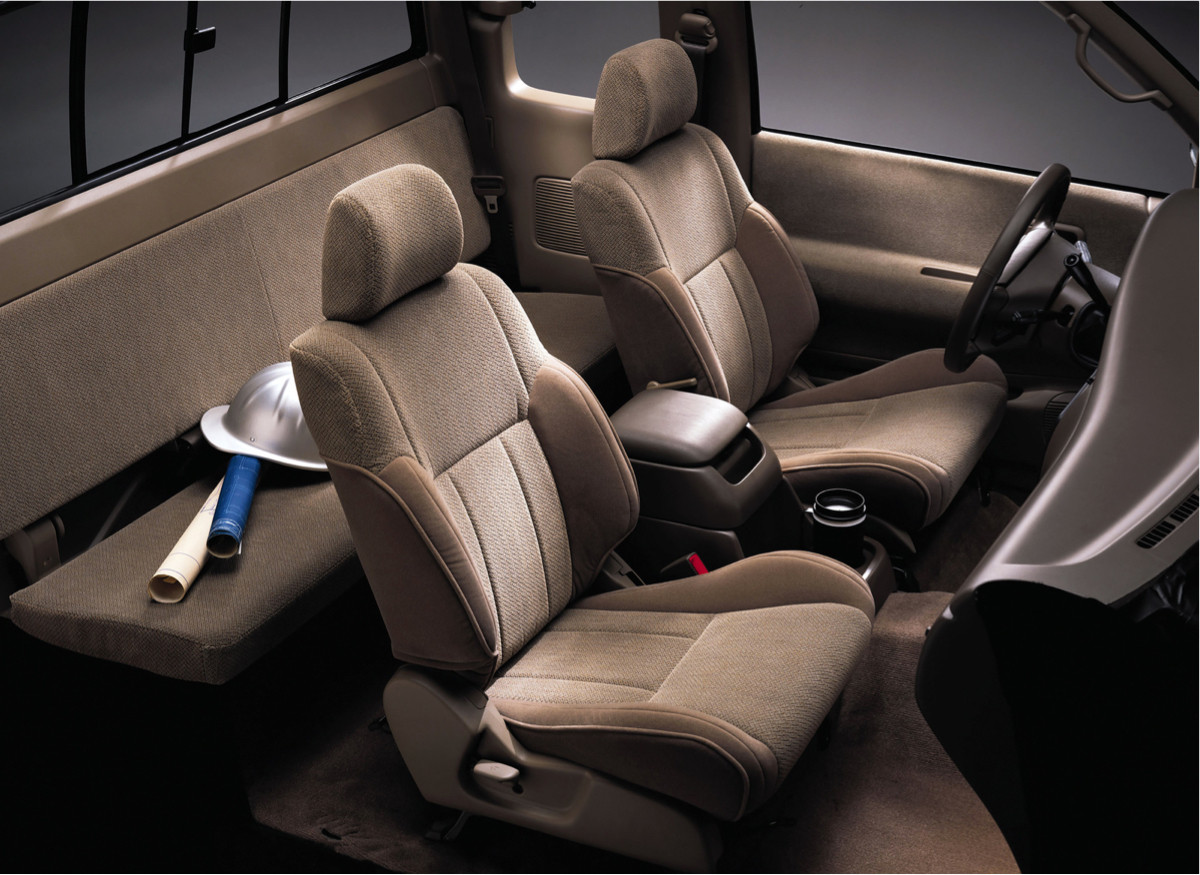 T100 Xtracab Interior
T100 Xtracab Interior
The interior of the Toyota T100 was praised for its high-quality materials, thoughtful design, and comfortable seating. The dashboard was well-organized and easy to read, with intuitive controls and ample storage space. The seats were supportive and well-cushioned, providing a comfortable ride even on long trips. The T100 also offered a range of convenience features, such as power windows, power locks, and air conditioning. While the T100’s interior wasn’t as luxurious as some of its competitors, it was functional, durable, and well-built. At millertoyota.net, we believe that a comfortable and well-designed interior is essential for a positive driving experience, and we’re committed to offering vehicles with interiors that meet your needs. Inside the Toyota T100 Xtracab, showcasing the spacious and well-maintained interior.
17. How Did the T100’s Size Compare to Other Toyota Trucks?
Compared to other Toyota trucks, the T100 was larger than the compact Toyota Pickup but smaller than the full-size Toyota Tundra. The T100’s dimensions placed it in a unique position in the Toyota truck lineup, appealing to buyers who wanted something bigger than a compact truck but didn’t need the full-size capabilities of the Tundra. The T100’s size made it easier to maneuver and park than the Tundra, but it also limited its towing and hauling capacity. If you’re unsure which Toyota truck is right for you, visit millertoyota.net and our knowledgeable staff can help you compare models and find the perfect fit.
18. What Was the Fuel Economy of the Toyota T100?
The fuel economy of the Toyota T100 varied depending on the engine and transmission. Models with the 3.0-liter V6 engine averaged around 17 mpg in the city and 21 mpg on the highway. Those with the 2.7-liter inline-4 engine achieved slightly better fuel economy, while those with the 3.4-liter V6 engine offered similar fuel economy to the 3.0-liter V6. While the T100’s fuel economy was decent for a truck of its size, it wasn’t as good as some of its competitors, particularly those with smaller engines. If fuel economy is a top priority, visit millertoyota.net to explore Toyota’s hybrid and fuel-efficient models.
19. What Aftermarket Modifications Were Popular for the Toyota T100?
Despite its limited production numbers, the Toyota T100 developed a following among off-road enthusiasts and truck customizers. Popular aftermarket modifications included lift kits, off-road tires, custom bumpers, and performance upgrades. These modifications enhanced the T100’s off-road capabilities and gave it a more aggressive appearance. Many T100 owners also added accessories such as bed liners, tonneau covers, and aftermarket sound systems.
20. What Impact Did the Toyota T100 Have on the Automotive Industry?
While the Toyota T100 wasn’t a commercial success, it had a significant impact on the automotive industry. It demonstrated that there was a market for a refined and reliable truck that was smaller and more manageable than traditional full-size pickups. The T100 also paved the way for the later, more successful Toyota Tundra, which has become a major player in the full-size truck market. The T100’s legacy lives on in the Tundra and other Toyota trucks, which continue to offer a blend of quality, reliability, and innovation. At millertoyota.net, we’re proud to be a part of Toyota’s history and we’re committed to providing you with the best possible automotive experience.
21. What Safety Features Were Included in the Toyota T100?
The Toyota T100 came standard with a range of safety features, including driver and passenger airbags, anti-lock brakes (ABS), and side-impact door beams. These features helped to protect occupants in the event of a collision. The T100 also featured a strong and durable frame, which provided additional protection in accidents. While the T100’s safety features weren’t as advanced as those found in modern vehicles, they were state-of-the-art for the time.
22. How Did the Toyota T100 Handle in Off-Road Conditions?
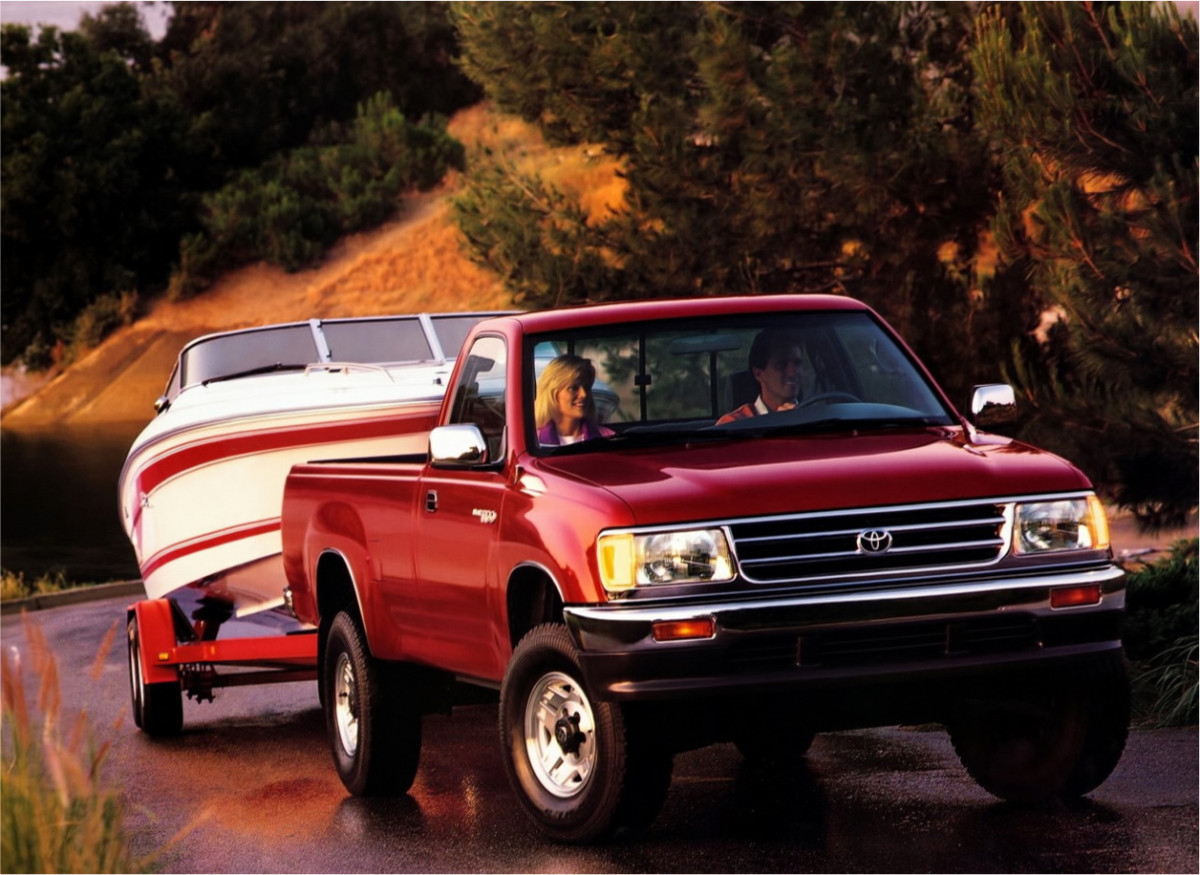 Toyota T100 towing
Toyota T100 towing
The Toyota T100 was a capable off-road vehicle, thanks to its durable suspension, high ground clearance, and available four-wheel drive. Its smaller size and lighter weight made it more nimble and maneuverable than many full-size trucks, allowing it to navigate tight trails and challenging terrain. The T100’s torquey engines provided plenty of power for climbing hills and overcoming obstacles. While the T100 wasn’t as extreme as some dedicated off-road vehicles, it was a reliable and capable choice for recreational off-roading. At millertoyota.net, we offer a range of Toyota trucks with off-road capabilities, including the Tacoma and Tundra TRD Pro models. A Toyota T100 performing a towing task, showcasing its capabilities.
23. What Trim Levels Were Offered for the Toyota T100?
The Toyota T100 was offered in a range of trim levels, including DX, SR5, and Limited. The DX was the base model, offering a basic level of equipment and features. The SR5 added features such as air conditioning, power windows, and upgraded upholstery. The Limited was the top-of-the-line model, featuring leather seats, a premium sound system, and other luxury features. Each trim level offered a different combination of features and equipment, allowing buyers to choose the model that best fit their needs and budget.
24. How Many Different Cab Configurations Were Available for the Toyota T100?
The Toyota T100 was initially offered with a standard cab configuration, which could seat up to three passengers. In 1995, Toyota introduced an extended cab configuration, known as the Xtracab, which added rear jump seats and increased passenger capacity to a maximum of six. The Xtracab was a popular choice among buyers who needed to transport more passengers or wanted additional storage space. The T100 was not offered with a crew cab configuration, which limited its appeal to some buyers.
25. Where Was the Toyota T100 Manufactured?
The Toyota T100 was manufactured in Japan, unlike the later Toyota Tundra, which is assembled in North America. The T100’s Japanese origins contributed to its reputation for quality and reliability, as Toyota’s manufacturing processes in Japan are known for their precision and attention to detail. However, the T100’s production in Japan also made it more expensive than some of its American-made competitors.
26. What Colors Was the Toyota T100 Offered In?
The Toyota T100 was offered in a range of colors, including:
| Color Name | Color Code |
|---|---|
| Black | 202 |
| White | 045 |
| Red | 3H4 |
| Blue | 8J5 |
| Green | 6M1 |
| Gray | 1A5 |
| Beige | 4M7 |
These colors allowed buyers to personalize their T100s and choose a shade that reflected their personal style. Some colors were more popular than others, and certain colors may have been limited to specific trim levels or model years.
27. How Did the Toyota T100 Perform in Crash Tests?
The Toyota T100 performed well in crash tests conducted by the National Highway Traffic Safety Administration (NHTSA). The T100 received a four-star rating for driver-side impact protection and a three-star rating for passenger-side impact protection. These ratings indicated that the T100 provided a good level of protection for occupants in the event of a collision. While the T100’s crash test performance wasn’t perfect, it was comparable to that of other trucks of the era.
28. What Was the Base Price of the Toyota T100 When New?
The base price of the Toyota T100 when new ranged from around $14,000 to $20,000, depending on the trim level and model year. The DX model was the most affordable, while the Limited model was the most expensive. These prices were competitive with those of other trucks in the mid-size and light-duty full-size segments. However, the T100’s lack of a V8 engine and limited cab configurations may have made it less appealing to some buyers, despite its competitive pricing.
29. How Did the Toyota T100 Compare to the Ford F-150 in Terms of Reliability?
The Toyota T100 was generally considered to be more reliable than the Ford F-150 of the same era. Toyota’s reputation for quality and dependability was well-earned, and the T100 was no exception. While the Ford F-150 was a popular and capable truck, it was also known for having more frequent and costly repairs. The T100’s simpler design and fewer features may have contributed to its greater reliability.
30. What Is the Resale Value of a Used Toyota T100 Today?
The resale value of a used Toyota T100 today varies depending on its condition, mileage, and location. Well-maintained T100s with low mileage can fetch a premium price, particularly those with rare features or desirable options. However, T100s with high mileage or significant damage may sell for significantly less. Overall, the T100 has held its value relatively well, thanks to its reputation for reliability and its growing popularity among collectors and enthusiasts.
31. What Technological Advancements Were Present in the Toyota T100?
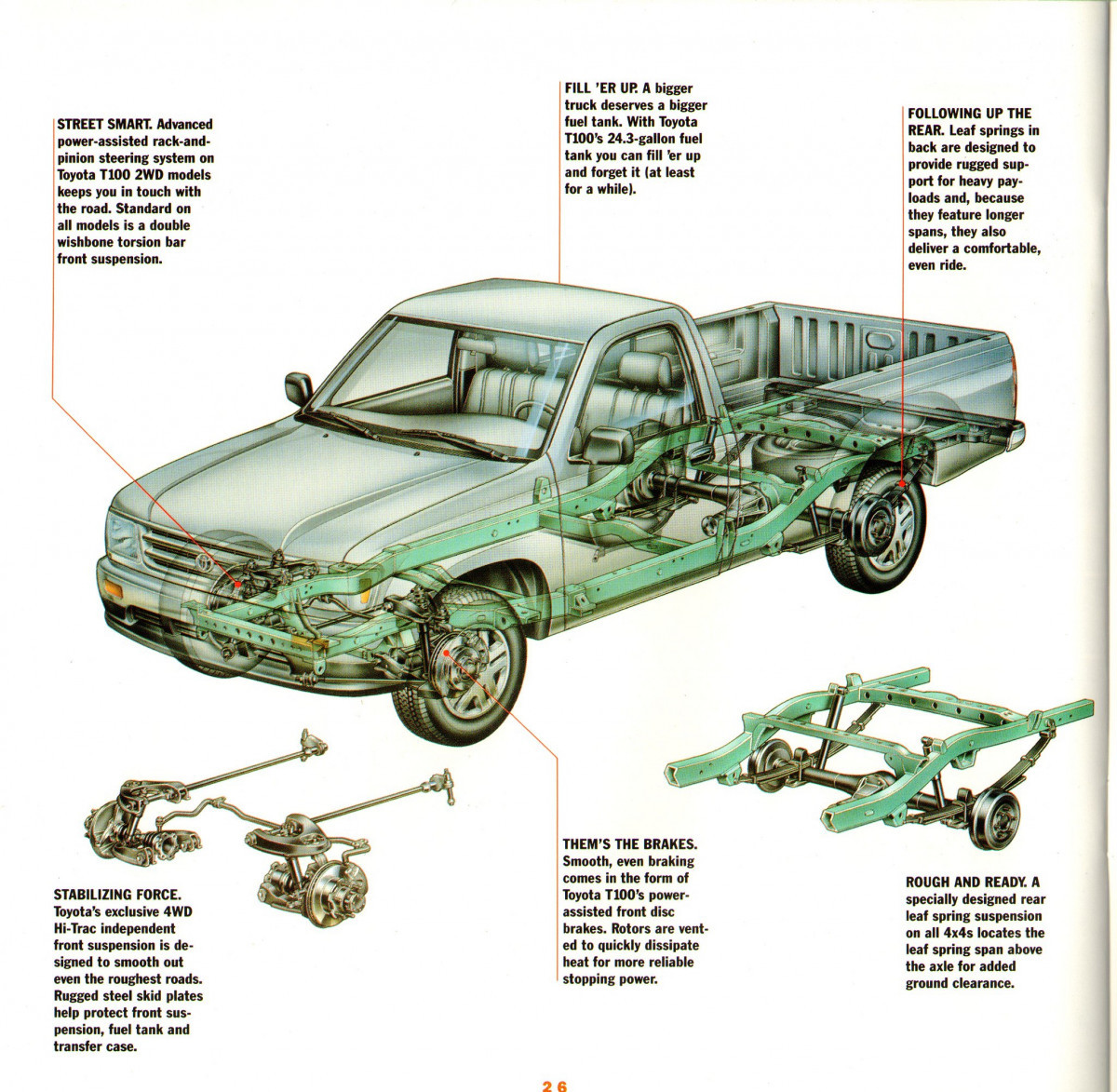 Toyota T100 cutaway
Toyota T100 cutaway
While the Toyota T100 wasn’t known for its cutting-edge technology, it did offer some notable advancements for its time. These included electronic fuel injection, which improved fuel economy and reduced emissions, and anti-lock brakes (ABS), which enhanced safety and control. The T100 also featured a modern and ergonomic interior design, which made it more comfortable and convenient to drive. While the T100’s technology may seem dated by today’s standards, it was state-of-the-art for the early 1990s. A detailed cutaway view of the Toyota T100, highlighting its engineering and design.
32. What Role Did the Toyota T100 Play in Toyota’s History?
The Toyota T100 played a crucial role in Toyota’s history, serving as the company’s first entry into the full-size pickup truck market in North America. While the T100 wasn’t a commercial success, it provided Toyota with valuable insights into the needs and preferences of American truck buyers. These insights helped Toyota to develop the later, more successful Tundra, which has become a major player in the full-size truck market. The T100’s legacy lives on in the Tundra and other Toyota trucks, which continue to offer a blend of quality, reliability, and innovation.
33. What Are Some Interesting Facts About the Toyota T100?
- The Toyota T100 was originally intended to be called the “T-150,” but Ford Motor Company threatened legal action, claiming that the name was too similar to its F-150 pickup truck.
- The T100 was the first Toyota truck to be designed specifically for the North American market.
- The T100’s smaller size and lighter weight made it popular among off-road enthusiasts, who often modified it for extreme terrain.
- The T100 was discontinued in 1998 and replaced by the larger, more powerful Toyota Tundra in 1999.
34. How Did the Toyota T100 Handle in Snowy Conditions?
The Toyota T100 was a capable vehicle in snowy conditions, particularly when equipped with four-wheel drive. Its high ground clearance allowed it to navigate deep snow, while its torquey engines provided plenty of power for climbing hills and maintaining traction. The T100’s anti-lock brakes (ABS) also helped to prevent wheel lockup on slippery surfaces, enhancing safety and control. However, like any vehicle, the T100 could be challenging to drive in extreme snow conditions, and drivers were advised to exercise caution and use appropriate tires. For those in Boise, Idaho, who need a reliable vehicle for winter driving, millertoyota.net offers a range of Toyota trucks and SUVs with four-wheel drive and advanced traction control systems.
35. How Many Toyota T100 Were Made with a Manual Transmission?
The exact number of Toyota T100s made with a manual transmission is not readily available, but it is estimated to be a relatively small percentage of the total production. Manual transmissions were offered as an option on the T100, but many buyers preferred the convenience of an automatic transmission. T100s with manual transmissions are relatively rare today, and they may command a premium price among collectors and enthusiasts.
36. What Type of Suspension System Did the Toyota T100 Have?
The Toyota T100 featured an independent front suspension and a solid rear axle with leaf springs. This suspension system provided a good balance of ride comfort and load-carrying capacity. The independent front suspension helped to absorb bumps and vibrations, while the solid rear axle provided stability and durability. The T100’s suspension system was well-suited to a variety of driving conditions, from paved roads to off-road trails.
37. What Are the Dimensions of the Toyota T100’s Bed?
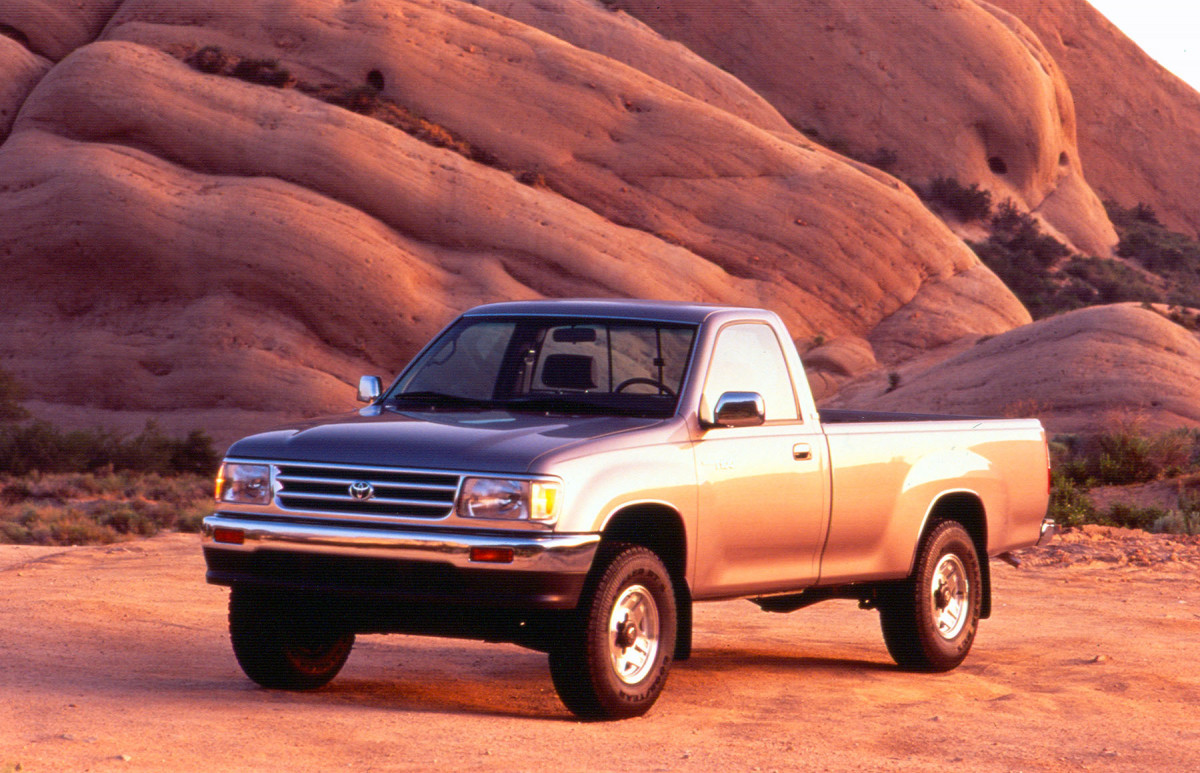 Toyota T100 grey
Toyota T100 grey
The Toyota T100 was offered with two different bed lengths:
- Standard Cab: 8 feet
- Xtracab: 6.3 feet
These bed lengths provided ample space for hauling cargo, making the T100 a versatile and practical truck. The longer bed on the standard cab model was ideal for carrying large items, while the shorter bed on the Xtracab model was more convenient for everyday use. At millertoyota.net, we understand the importance of having the right bed size for your needs, and we offer a range of Toyota trucks with different bed lengths and configurations. A gray Toyota T100, showing off its classic design.
38. What Kind of Warranty Did the Toyota T100 Have When It Was New?
The Toyota T100 came with a comprehensive warranty when it was new, including:
- 3-year/36,000-mile basic warranty
- 5-year/60,000-mile powertrain warranty
- 5-year/unlimited-mile corrosion warranty
These warranties provided peace of mind for T100 owners, knowing that they were protected against defects in materials and workmanship. While these warranties are no longer in effect for T100s today, they demonstrate Toyota’s commitment to quality and reliability. At millertoyota.net, we continue to offer industry-leading warranties on all new Toyota vehicles, providing you with the confidence you need to make a purchase.
39. How Did the Toyota T100 Compare to Other Toyota Vehicles in Terms of Reliability?
The Toyota T100 was generally considered to be one of the most reliable vehicles in the Toyota lineup. Toyota’s reputation for quality and dependability was well-earned, and the T100 was no exception. Many T100 owners have reported driving their trucks for hundreds of thousands of miles with minimal repairs. While no vehicle is perfect, the T100’s reputation for reliability is a testament to Toyota’s engineering and manufacturing excellence.
40. How Did the Toyota T100 Perform in Terms of Fuel Efficiency Compared to Its Competitors?
The Toyota T100’s fuel efficiency was on par with many of its competitors in the mid-size and light-duty full-size truck segments. Models with the 3.0-liter V6 engine averaged around 17 mpg in the city and 21 mpg on the highway. While these figures weren’t exceptional, they were decent for a truck of its size and capabilities. Some of the T100’s competitors offered slightly better fuel efficiency, but the T100’s reliability and durability often outweighed this difference.
41. What Kind of Axle Did the Toyota T100 Have?
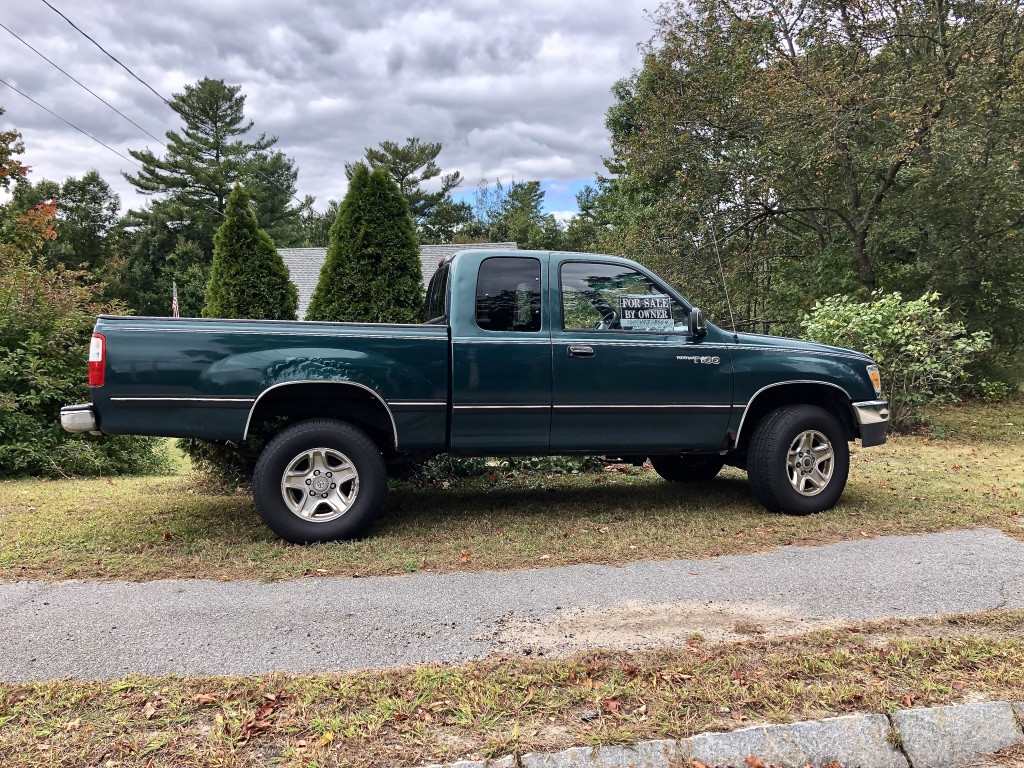 Toyota T100 zxiB4B4eRKSPBGWgdKoRgw thumb 9df8
Toyota T100 zxiB4B4eRKSPBGWgdKoRgw thumb 9df8
The Toyota T100 featured a solid rear axle, which provided strength and durability for hauling and towing. The solid rear axle was a common feature on trucks of the era, and it was well-suited to the T100’s intended use. The T100’s axle was designed to withstand the stresses of heavy loads and rough terrain, ensuring reliable performance in a variety of driving conditions. The rear of a Toyota T100 showcasing its durable axle and robust design.
42. What Type of Steering System Did the Toyota T100 Have?
The Toyota T100 featured a recirculating ball steering system, which was a common type of steering system used on trucks and SUVs of the era. This steering system provided a good balance of steering feel and effort, making the T100 easy to handle in a variety of driving conditions. While recirculating ball steering systems aren’t as precise as rack-and-pinion steering systems, they are durable and reliable, making them well-suited to the T100’s intended use.
43. What Were Some of the Challenges Toyota Faced During the Development of the T100?
Toyota faced several challenges during the development of the T100, including:
- Designing a truck that would appeal to American truck buyers, who had different tastes and preferences than Toyota’s traditional customers.
- Developing a truck that could compete with established domestic brands, such as Ford, Chevrolet, and Dodge.
- Ensuring that the T100 met all U.S. safety and emissions regulations.
- Keeping the T100’s price competitive while maintaining Toyota’s high standards of quality and reliability.
Despite these challenges, Toyota successfully developed the T100 and launched it in the North American market in 1992.
44. What Were Some of the Common Complaints About the Toyota T100?
Some of the common complaints about the Toyota T100 included:
- Lack of a V8 engine option.
- Limited cab configurations (no crew cab).
- Smaller size compared to full-size trucks.
- Underpowered engines (particularly the 3.0-liter V6).
- Higher price compared to some competitors.
These complaints contributed to the T100’s limited sales success, as many buyers wanted a truck with more power, more space, and a lower price.
45. What Type of Brakes Did the Toyota T100 Have?
The Toyota T100 featured disc brakes on the front wheels and drum brakes on the rear wheels. This braking system provided adequate stopping power for most driving conditions. The T100 also came standard with anti-lock brakes (ABS), which helped to prevent wheel lockup on slippery surfaces, enhancing safety and control.
46. What Are the Best Years to Buy a Toyota T100?
The best years to buy a Toyota T100 are generally considered to be the 1995-1998 models. These models featured the upgraded 3.4-liter V6 engine, which provided more power and better performance than the earlier 3.0-liter V6. The 1995-1998 models also benefited from some minor styling and feature updates. However, any well-maintained T100 can be a good buy, regardless of the model year.
47. Where Can I Find Parts for a Toyota T100?
Parts for a Toyota T100 can be found at a variety of sources, including:
- Toyota dealerships
- Auto parts stores
- Online retailers
- Junkyards
Toyota dealerships are the best source for genuine Toyota parts, but they may be more expensive than other options. Auto parts stores offer a wide selection of aftermarket parts, which can be more affordable than genuine Toyota parts. Online retailers offer a convenient way to shop for parts from the comfort of your home. Junkyards can be a good source for used parts, but it’s important to inspect the parts carefully before buying them.
48. How Did the Toyota T100 Contribute to Toyota’s Success in the North American Market?
While the Toyota T100 wasn’t a commercial success in and of itself, it played an important role in Toyota’s overall success in the North American market. The T100 demonstrated that Toyota was serious about competing in the truck segment, and it helped to build Toyota’s reputation for quality and reliability among truck buyers. The T100 also provided Toyota with valuable insights into the needs and preferences of American truck buyers, which helped the company to develop the later, more successful Tundra.
49. How Can I Learn More About the Toyota T100?
You can learn more about the Toyota T100 from a variety of sources, including:
- Online forums and communities
- Automotive websites and blogs
- Books and magazines
- Toyota dealerships
Online forums and communities are a great way to connect with other T100 owners and enthusiasts. Automotive websites and blogs offer a wealth of information about the T100, including reviews, specifications, and owner experiences. Books and magazines provide in-depth coverage of the T100’s history and development. Toyota dealerships can provide you with information about the T100’s features and specifications, as well as service and parts.
50. Was the Toyota T100 a Good Truck?
Whether the Toyota T100 was a good truck is subjective and depends on individual needs and preferences. It offered Toyota’s signature reliability, a comfortable ride, and a manageable size. However, it lacked the power and capability of full-size trucks and was discontinued after a short production run. Despite its shortcomings, the T100 remains a popular choice among enthusiasts and collectors, and it played an important role in Toyota’s history.
At millertoyota.net, we believe that the Toyota T100 was a good truck for what it was designed to do, and we are proud to offer a wide range of Toyota trucks and SUVs that meet the needs of today’s drivers.
Considering upgrading to a newer Toyota model or need expert service for your current vehicle? Visit us at millertoyota.net or stop by our dealership at 208 N Maple Grove Rd, Boise, ID 83704, United States. You can also reach us at +1 (208) 376-8888. Let Miller Toyota be your trusted partner for all your automotive needs. Explore our models today!